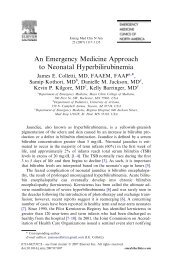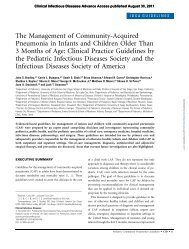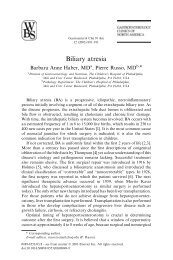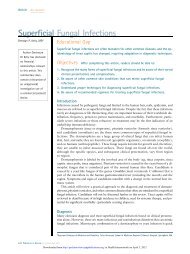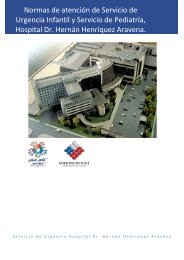An 11-year-old Girl Who Has Left Leg Pain
An 11-year-old Girl Who Has Left Leg Pain
An 11-year-old Girl Who Has Left Leg Pain
You also want an ePaper? Increase the reach of your titles
YUMPU automatically turns print PDFs into web optimized ePapers that Google loves.
ethics for the pediatriciandiscredited thoroughly. A 1964 reportto Congress on deaf education calledoralism a “dismal failure.” The reportrecommended new approaches to theeducation of children who are deaf.(4) Oralism failed, in part, becauselip reading (or “speechreading”) isdifficult and never perfect. Onlyw30% to 35% of English sounds canbe speechread. Words as different as“queen” and “white” look the sameon a person’s lips. So do the threewords in the sentence, “Buymypie”.(5) Sign language, by contrast, allowsstudents who are deaf to understandall that is being communicated.In recent <strong>year</strong>s, this stark exclusivityhas all but disappeared. Most educatorstoday prefer methods thatcombine lip reading, speech, and signlanguage, and are known collectivelyas “total communication”. (6) Still, the<strong>year</strong>s during which signing was prohibitedin schools for the deaf left deepscars. Signing became a matter of deeppride and cultural identity within theDeaf community. (7) This history explains,in part, the response of many inthe Deaf community to cochlear implants.They saw implants as a returnto the philosophy of oralism and a rejectionof sign language.The Controversy OverCochlear Implants forChildrenIn 1957, Djourno and Eyries were thefirst surgeons to implant an electrodein a patient’s cochlea. (8) Over the nextdecades, others developed the technology.Between 1965 and 1970, Housedeveloped single-electrode cochlearimplants and teamed up with 3M tomake the first commercial cochlearimplants in the United States. Thesedevices were first marketed in 1972,and in 1984 they were approved bythe Food and Drug Administration(FDA) for use in adults.In the mid-1970s, Clarke developeda multielectrode cochlear implant, andfirst implanted an adult patient withhis prototype device in 1978. Multichanneldevices divide the incomingsignal into various frequency bandsthat are then transmitted to varioussites of stimulation spanning the innerear. Low-pitch sounds are sent to onepart of the cochlea, high-pitch soundsto another, more closely mimickingthe human ear. Because multiplechannels provide a more detailedrepresentation of sound, they arethought to allow better speech understandingthan do single-channeldevices. Clarke’s multichannel devicewas approved in 1985. Throughoutthese <strong>year</strong>s, implants were being offeredto children, although they werenot yet approved by the FDA for usein pediatric populations.In 1990, the FDA approved theuse of cochlear implants for childrenover age 2 <strong>year</strong>s. This decision led toa firestorm of controversy. The next<strong>year</strong>, the National Association of theDeaf (NAD) issued a statement deploringthe FDA’s approval decision.(9) They argued that cochlear implantsfor children remained highlyexperimental. They accused the FDAof “failing to consult formally withorganizations of deaf Americans andwith deaf leaders and scholars knowledgeableabout the acquisition anduse of sign communication and Englishin deaf children, the psychosocialdevelopment and educationof deaf children, and the social organizationand culture of the AmericanDeaf community.” Most controversially,the NAD claimed that deafness“comprises a linguistic and culturalminority,” and that “we should notseek the scientific tools nor use them,if available, to change a child biologicallyso he or she will belong to themajority rather than the minority –even if we believe that this biologicalengineering might reduce the burdensthe child will bear as a memberof a minority.” They recommendeda national conference to address theethical issues surrounding cochlearimplants for children.In 1995, a conference was convenedat the National Institutes ofHealth (NIH) to address some ofthe issues raised by cochlear implants.Of note, it was not the conferencethat the NAD had recommended.Instead, the scope was much morelimited. According to the organizers,“The conference was convened tosummarize current knowledge aboutthe range of benefits and limitationsof cochlear implantation that have accruedto date. Such knowledge is animportant basis for informed choicesfor individuals and their familieswhose philosophy of communicationis dedicated to spoken discourse. Issuesrelated to the acquisition of signlanguage were not addressed directlyby the panel, because the focus ofthe conference was on new informationon cochlear implant technologyand its use. The panel acknowledgesthe value and contributions of bilingualand bicultural approaches todeafness”. (10) Conference panelistswere drawn from “the fields ofotolaryngology, audiology, speechlanguagepathology, pediatrics, psychology,and education, and includinga public representative.” There was norepresentative from Deaf culture. Thegoal of the conference was to makerecommendations to the NIH andthe FDA about cochlear implants.More than 600 people attended.The conclusions of the consensusconference were as follows: “Cochlearimplantation improves communicationability in most adults with severeto-profounddeafness and frequentlyleads to positive psychological andsocial benefits as well. Currently,children at least 2 <strong>year</strong>s <strong>old</strong> and adultswith profound deafness are candidatesfor implantation. Cochlear implantcandidacy should be extended to adultswith severe hearing impairment and324 Pediatrics in Review Vol.33 No.7 July 2012Downloaded from http://pedsinreview.aappublications.org/ by Enrique Mendoza-Lopez on July 2, 2012



